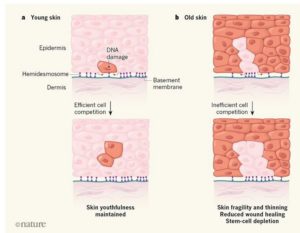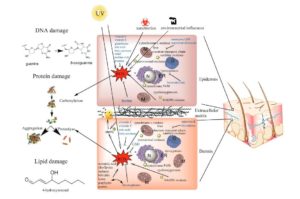Why is old skin so thin?
I always had my own explanation: when we age, we have less blood vessels reaching our dermis, and nutrition decreases. Also, production of growth factors decreases. Mitochondria get “older” and are less efficient at producing energy. These statements are based on research. In fact, I am sure that almost everything has changed in my skin since I was a little girl. But this does not mean that changing those things back (assuming it would be possible!) would have a rejuvenating effect. And it is not enough to speculate, I would ask for proof and, if possible, a mechanism of action. This is why I like the latest news from the basic scientists working to understand how the skin works.
Now, with Liu et al. (2019) there is a new explanation: stem cells produce daughter cells that are “unfit”, they can’t anchor properly to the basal membrane and get shed and lost.
We also have a new “hero” active: apocynin, which promotes the synthesis of a protein, collagen 17, crucial for proper anchoring. The cells that express this protein will be able to anchor, divide “properly” and become part of the skin, making it thicker, restoring health and a good skin barrier.
From the glossary:
Apocynin, a.k.a. 1-(4-Hydroxy-3-methoxyphenyl)ethan-1-one, is chemically related to vanillin. It is present, at low concentrations, in vanilla extract and is also found in other plants, including Canadian hemp (Apocynum cannabinum) and Picrorhiza kurroa, a plant that grows in the Himalayas. Apocynin inhibits an enzyme, NADPH oxidase, and in so doing it decreases oxidative stress; it also has anti-inflammatory activity. It promotes the survival of stem cells and the cells derived from stem cells by promoting synthesis of collagen 17, a protein crucial to the anchoring of the new cells to the dermal/epidermal junction, preventing skin thinning and premature aging.

Figure: apocynin promotes synthesis of COL17, which helps “anchor” cells to the dermal/epidermal junction.
ROS BioNet This unique complex contains glutaredoxin, thioredoxin and superoxide dismutase, three proteins crucial in the disarming of reactive oxygen species (ROS*) reaching the skin and those produced in the skin. Working in the context of the glutathione cycle, this complex will prevent damage to the structure and function of skin’s lipids, proteins (like elastin and collagen) and DNA. The skin is exposed to continuous attack by ROS*, major contributors to skin aging and hyperpigmentation and ROS BioNET is an essential tool in skin protection by promoting an optimal redox environment.

Figure: the amazing complexity of the antioxidant system that prevents destruction of the skin macromolecules.
As always, the right mix of antioxidants will keep oxidative stress at bay, preventing DNA mutations and accelerated telomere erosion.
Please have a look at the new Skin Actives products, containing apocynin and ROS BioNet, plus the other actives your skin needs to maintain its health and keep your body healthy for longer, allowing we to enjoy life. And don’t forget the all-important growth factors!
Skin Actives new products with Ros BioNet and Apocynin
Vitamin A cream with ROS BioNet and apocynin
Reference
Liu et al (2019) Stem cell competition orchestrates skin homeostasis and ageing, Nature, 568:1-7
DISCLAIMER: These claims have not been evaluated by the FDA and are not intended to diagnose, cure, treat or prevent any disease.
